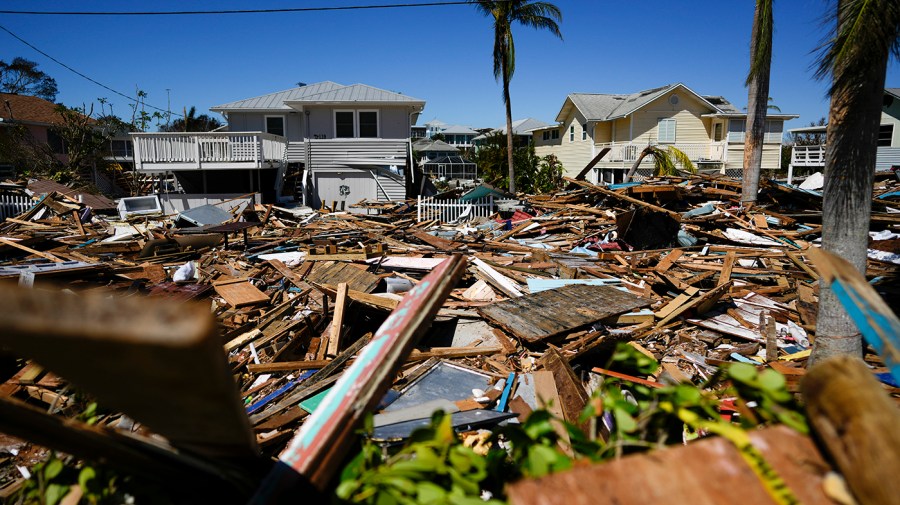Business
Climate change raising risks of financial disaster for home owners, insurers and bankers on August 30, 2023 at 10:09 pm Business News | The Hill

The rising weather-related risks from climate change, from coastal hurricanes to western wildfires, are increasing pinching insurance companies, which are raising rates and pulling back from parts of the country in an effort to stay in business.
Just this summer, two major insurance companies left Florida, adding to the long list of companies that have left the state.
In July, Farmers Insurance announced it would no longer write policies in the state; in August, United Property and Casualty went bankrupt, leaving 22,000 of Floridians high and dry, and all Florida residents having to foot the bill to bail it out.
Banks could be next, said Dennis Kelleher of public interest nonprofit Better Markets.
“The banking crisis is only right behind the climate and insurance crisis,” Kelleher told The Hill. “Every time an insurance company sounds an alarm, the banks ought to be shaking in their boots, because they’re getting the bill.”
Unprecedented disasters
The unprecedented hurricane cutting across the Florida Panhandle is just the latest in a string of billion-plus dollar disasters to hit the United States this year.
As of early August — before the fires that leveled Lahaina, and before Hurricanes Hilary and Idalia — the U.S. had experienced 15 climate disasters with losses exceeding $1 billion, according to federal data.
Those disasters are becoming more frequent. In the 1980s, an average of almost three months separated such large-scale disasters — but for the last five years, they’ve been coming about every three weeks.
The backstop to these losses is the insurance industry, which has seen its costs increase exponentially in recent years. In 2021, the industry as a whole paid out nearly $4 billion more than it took in — and in 2022, following Hurricane Ian, those losses ballooned more than six times to nearly $27 billion, according to a review by a leading insurance trade group.
In the wake of these disasters, some insurance companies have left areas where the risk is highest, leasing an increasing numbers of Americans without insurance, according to the Wall Street Journal.
That’s in turn a risks for banks, since nearly two-thirds of U.S. home owners are paying a mortgage to a lender — generally a bank.
Banks, in turn, use these homes as collateral in a dizzying array of loans and associated financial derivatives — all of which are based, Kelleher argued, on the increasingly obsolete assumption that the properties themselves are backed by insurance.
In the past, this largely made sense. Banks didn’t worry about losing the real estate the loans were written against — they worried about maintaining the tightest possible spread between the equity homeowners were paying in, and the potential losses if they defaulted.
This assumption allowed banks to assume a loan-to-deposit ratio of 80 to 90 percent — in which a bank may only have $.10 or $.20 in deposits or real assets for every dollar it’s lending out.
That kind of ratio gives “very little cushion, but at the end of the day, it’s okay because you’ve got the physical assets,” Kelleher said.
But with the rise of climate change driven disasters, “the quality and reliability of the physical assets have dropped dramatically.”
Add the departure of insurance companies, he argued, and banks face the possibility of undergoing total losses for properties destroyed by disaster — losses that, in previous ages, insurance payments would have largely made up.
Kelleher argued that a wave of defaults is coming — one which will hit small community and regional banks first.
“We’re not talking about a decade, we’re talking over the next several years of there being significant bank and financial system consequences for what the insurance companies are experiencing right now,” he said.
A lack of data
It’s unclear how many uninsured properties exist in the United States, which itself is a danger.
“While you would think that state insurance regulators would have created such a database and series of reports through the National Association of Insurance Commissioners, this is unfortunately not the case,” Carly Fabian, a specialist in insurance and climate change at nonprofit Public Citizen told the Hill.
Regulators are struggling to catch up. The National Association of Insurance Commissioners in August announced it would build a comprehensive data-set to help identify where “insurance availability and affordability” is more challenging in the U.S.
That’s a move it had once opposed, Fabian noted, “which suggests they’re feeling pressure” to get more data on the problem.
Some progressive lawmakers want state insurers to focus on collecting data to figure out where the risks are worse.
“If you purchase a home in Pensacola today, current sea level rise projections through 2050 mean that your home will likely be under water before your mortgage is paid off,” Rep. Sean Casten (D-Ill.) told The Hill.
He added that as insurance firms catch on and stop writing policies in those areas, “a cascading effect” risks spreading through the financial system, as financial institutions offload loans, potentially threatening U.S. financial stability.
“Congress and federal regulators have an obligation to do more to address this,” Casten said.
Kelleher argued that financial regulators need to demand “stress tests,” in which key banking regulators — the Federal Reserve, the Office of Comptroller of the Currency, and the FDIC — require banks to audit their risk of failure in the face of different levels of serious climate upheaval.
Even where these tests are performed, it isn’t clear that banks are taking them seriously. In a stress test performed by the European Central Bank (ECB), a world in which global heating reaches 3 degrees Celsius by 2050 — three times its current level — banks assumed their total losses would be just $78 billion.
This number, the ECB itself noted, “significantly understates the actual climate-related risk.”
The role of fossil fuels
In the U.S., there’s an added issue: both regulators and banks are taking heavy fire from the GOP and the broader fossil fuel industry, which is fighting hard to maintain a free flow of credit to the fossil fuel industry.
When the Federal Reserve last year announced it was opening an initial pilot project that would require six banks to audit their climate risk, Republicans cried foul, arguing this was the beginning of a move to defund fossil fuels.
“The Fed’s new ‘pilot’ program is the first step toward pressuring banks into limiting loans to and investments in traditional energy companies and other disfavored carbon-emitting sectors,” Sen. Pat Toomey, ranking member of the Banking Committee, said in a statement.
“There is no risk from global warming that banks aren’t already fully capable of pricing into their decisions, and the Fed’s intrusion into this process only underscores that the real risk is government.”
Whether or not banks are capable, they are “light years” behind insurance, Kelleher said.
“Bankers are all tied up with, you know, accusations of wokeness, and the power and influence of the oil and gas industry. They should be more like the insurance industry, which is, who cares why a climate disaster is coming?”
“The only thing they should care about is, what the risks are, and what they should do about the risks.”
But while they’re attitude to reducing their direct exposure to climate change may be different, in one way, Fabian of Public Citizen noted, banking and insurance see eye to eye: both are happy to keep investing in the very fossil fuels whose combustion makes the problem worse.
“Even as they pull away from homeowners, insurers like State Farm remain major investors in fossil fuels and others like AIG are both major investors and major underwriters of fossil fuel projects and companies,” she said.
Equilibrium & Sustainability, Business, Energy & Environment, News, State Watch, California, Florida, Home insurance, Hurricane Ian, hurricane idalia The rising weather-related risks from climate change, from coastal hurricanes to western wildfires, are increasing pinching insurance companies, which are raising rates and pulling back from parts of the country in an effort to stay in business. Just this summer, two major insurance companies left Florida, adding to the long list of companies that have…
Business
Harvard Grads Jobless? How AI & Ghost Jobs Broke Hiring

America’s job market is facing an unprecedented crisis—and nowhere is this more painfully obvious than at Harvard, the world’s gold standard for elite education. A stunning 25% of Harvard’s MBA class of 2025 remains unemployed months after graduation, the highest rate recorded in university history. The Ivy League dream has become a harsh wakeup call, and it’s sending shockwaves across the professional landscape.

Jobless at the Top: Why Graduates Can’t Find Work
For decades, a Harvard diploma was considered a golden ticket. Now, graduates send out hundreds of résumés, often from their parents’ homes, only to get ghosted or auto-rejected by machines. Only 30% of all 2025 graduates nationally have found full-time work in their field, and nearly half feel unprepared for the workforce. “Go to college, get a good job“—that promise is slipping away, even for the smartest and most driven.
Tech’s Iron Grip: ATS and AI Gatekeepers
Applicant tracking systems (ATS) and AI algorithms have become ruthless gatekeepers. If a résumé doesn’t perfectly match the keywords or formatting demanded by the bots, it never reaches human eyes. The age of human connection is gone—now, you’re just a data point to be sorted and discarded.
AI screening has gone beyond basic qualifications. New tools “read” for inferred personality and tone, rejecting candidates for reasons they never see. Worse, up to half of online job listings may be fake—created simply to collect résumés, pad company metrics, or fulfill compliance without ever intending to fill the role.
The Experience Trap: Entry-Level Jobs Require Years
It’s not just Harvard grads who are hurting. Entry-level roles demand years of experience, unpaid internships, and portfolios that resemble a seasoned professional, not a fresh graduate. A bachelor’s degree, once the key to entry, is now just the price of admission. Overqualified candidates compete for underpaid jobs, often just to survive.
One Harvard MBA described applying to 1,000 jobs with no results. Companies, inundated by applications, are now so selective that only those who precisely “game the system” have a shot. This has fundamentally flipped the hiring pyramid: enormous demand for experience, shrinking chances for new entrants, and a brutal gauntlet for anyone not perfectly groomed by internships and coaching.
Burnout Before Day One
The cost is more than financial—mental health and optimism are collapsing among the newest generation of workers. Many come out of elite programs and immediately end up in jobs that don’t require degrees, or take positions far below their qualifications just to pay the bills. There’s a sense of burnout before careers even begin, trapping talent in a cycle of exhaustion, frustration, and disillusionment.
Cultural Collapse: From Relationships to Algorithms
What’s really broken? The culture of hiring itself. Companies have traded trust, mentorship, and relationships for metrics, optimizations, and cost-cutting. Managers no longer hire on potential—they rely on machines, rankings, and personality tests that filter out individuality and reward those who play the algorithmic game best.
AI has automated the very entry-level work that used to build careers—research, drafting, and analysis—and erased the first rung of the professional ladder for thousands of new graduates. The result is a workforce filled with people who know how to pass tests, not necessarily solve problems or drive innovation.
The Ghost Job Phenomenon
Up to half of all listings for entry-level jobs may be “ghost jobs”—positions posted online for optics, compliance, or future needs, but never intended for real hiring. This means millions of job seekers spend hours on applications destined for digital purgatory, further fueling exhaustion and cynicism.
Not Lazy—Just Locked Out
Despite the headlines, the new class of unemployed graduates is not lazy or entitled—they are overqualified, underleveraged, and battered by a broken process. Harvard’s brand means less to AI and ATS systems than the right keyword or résumé format. Human judgment has been sidelined; individuality is filtered out.

What’s Next? Back to Human Connection
Unless companies rediscover the value of human potential, mentorship, and relationships, the job search will remain a brutal numbers game—one that even the “best and brightest” struggle to win. The current system doesn’t just hurt workers—it holds companies back from hiring bold, creative talent who don’t fit perfect digital boxes.
Key Facts:
- 25% of Harvard MBAs unemployed, highest on record
- Only 30% of 2025 grads nationwide have jobs in their field
- Nearly half of grads feel unprepared for real work
- Up to 50% of entry-level listings are “ghost jobs”
- AI and ATS have replaced human judgment at most companies
If you’ve felt this struggle—or see it happening around you—share your story in the comments. And make sure to subscribe for more deep dives on the reality of today’s economy and job market.
This is not just a Harvard problem. It’s a sign that America’s job engine is running on empty, and it’s time to reboot—before another generation is locked out.
Business
Why 9 Million Americans Have Left

The Growing American Exodus
Nearly 9 million Americans now live outside the United States—a number that rivals the population of several states and signals a profound shift in how people view the American dream. This mass migration isn’t confined to retirees or the wealthy. Thanks to remote work, digital nomad visas, and mounting pressures at home, young professionals, families, and business owners are increasingly joining the ranks of expats.

Rising Costs and Shrinking Wallets
Living in the US has become increasingly expensive. Weekly grocery bills topping $300 are not uncommon, and everyday items like coffee and beef have surged in price over the last year. Rent, utilities, and other essentials also continue to climb, leaving many Americans to cut meals or put off purchases just to make ends meet. In contrast, life in countries like Mexico or Costa Rica often costs just 50–60% of what it does in the US—without sacrificing comfort or quality.
Health Care Concerns Drive Migration
America’s health care system is a major trigger for relocation. Despite the fact that the US spends more per person on health care than any other country, millions struggle to access affordable treatment. Over half of Americans admit to delaying medical care due to cost, with households earning below $40,000 seeing this rate jump to 63%. Many expats point to countries such as Spain or Thailand, where health care is both affordable and accessible, as a major draw.

Seeking Safety Abroad
Public safety issues—especially violent crime and gun-related incidents—have made many Americans feel unsafe, even in their own communities. The 2024 Global Peace Index documents a decline in North America’s safety ratings, while families in major cities often prioritize teaching their children to avoid gun violence over simple street safety. In many overseas destinations, newly arrived American families report a significant improvement in their sense of security and peace of mind.
Tax Burdens and Bureaucracy
US tax laws extend abroad, requiring expats to file annual returns and comply with complicated rules through acts such as FATCA. For some, the burden of global tax compliance is so great that thousands relinquish their US citizenship each year simply to escape the paperwork and scrutiny.
The Digital Nomad Revolution
Remote work has unlocked new pathways for Americans. Over a quarter of all paid workdays in the US are now fully remote, and more than 40 countries offer digital nomad visas for foreign professionals. Many Americans are leveraging this opportunity to maintain their US incomes while cutting costs and upgrading their quality of life abroad.

Conclusion: Redefining the Dream
The mass departure of nearly 9 million Americans reveals deep cracks in what was once considered the land of opportunity. Escalating costs, inaccessible healthcare, safety concerns, and relentless bureaucracy have spurred a global search for better options. For millions, the modern American dream is no longer tied to a white-picket fence, but found in newfound freedom beyond America’s borders.
Business
Will Theaters Crush Streaming in Hollywood’s Next Act?

Hollywood is bracing for a pivotal comeback, and for movie lovers, it’s the kind of shake-up that could redefine the very culture of cinema. With the freshly merged Paramount-Skydance shaking up its strategy, CEO David Ellison’s announcement doesn’t just signal a change—it reignites the passion for moviegoing that built the magic of Hollywood in the first place.

Theatrical Experience Roars Back
Fans and insiders alike have felt the itch for more event movies. For years, streaming promised endless options, but fragmented attention left many longing for communal spectacle. Now, with Paramount-Skydance tripling its film output for the big screen, it’s clear: studio leaders believe there’s no substitute for the lights, the hush before the opening credits, and the collective thrill of reacting to Hollywood’s latest blockbusters. Ellison’s pivot away from streaming exclusives taps deep into what unites cinephiles—the lived experience of cinema as art and event, not just content.
Industry Pulse: From Crisis to Renaissance
On the financial front, the numbers are as electrifying as any plot twist. After years of doubt, the box office is roaring. AMC, the world’s largest theater chain, reports a staggering 26% spike in moviegoer attendance and 36% revenue growth in Q2 2025. That kind of momentum hasn’t been seen since the heyday of summer tentpoles—and it’s not just about more tickets sold. AMC’s strategy—premium screens, with IMAX and Dolby Cinema, curated concessions, and branded collectibles—has turned every new release into an event, driving per-customer profits up nearly 50% compared to pre-pandemic norms.
Blockbusters Lead the Culture
Forget the gloom of endless streaming drops; when films like Top Gun: Maverick, Mission: Impossible, Minecraft, and surprise hits like Weapons and Freakier Friday draw crowds, the industry—and movie fans—sit up and take notice. Movie-themed collectibles and concession innovations, from Barbie’s iconic pink car popcorn holders to anniversary tie-ins, have made each screening a moment worth remembering, blending nostalgia and discovery. The focus: high-impact, shared audience experiences that streaming can’t replicate.
Streaming’s Limits and Studio Strategy
Yes, streaming is still surging, but the tide may be turning. The biggest franchises, and the biggest cultural events, happen when audiences come together for a theatrical release. Paramount-Skydance’s shift signals to rivals that premium storytelling and box office spectacle are again at the center of Hollywood value creation. The result is not just higher profits for exhibitors like AMC, but a rebirth of movie-going as the ultimate destination for fans hungry for connection and cinematic adventure.

Future Forecast: Culture, Community, and Blockbuster Dreams
As PwC and others warn that box office totals may take years to fully catch up, movie lovers and industry leaders alike are betting that exclusive theatrical runs, enhanced viewing experiences, and fan-driven engagement are the ingredients for long-term recovery—and a new golden age. The Paramount-Skydance play is more than a business move; it’s a rallying cry for the art of the theatrical event. Expect more big bets, more surprises, and—finally—a long-overdue renaissance for the silver screen.
For those who believe in the power of cinema, it’s a thrilling second act—and the best seat in the house might be front and center once again.

 Business3 weeks ago
Business3 weeks agoWhy Are Influencers Getting $7K to Post About Israel?

 Health4 weeks ago
Health4 weeks agoWhy Did Gen Z QUIT Drinking Alcohol?

 Advice4 weeks ago
Advice4 weeks agoHow AI Is Forcing Everyone Into the Entrepreneur Game

 Entertainment3 weeks ago
Entertainment3 weeks agoKeith Urban and Nicole Kidman Split After 20 Years as Actress Files for Divorce

 Entertainment3 weeks ago
Entertainment3 weeks agoTilly Norwood’s Rise Stirs Controversy

 News3 weeks ago
News3 weeks agoHow a Government Shutdown Could Hit Your Life and Wallet

 Entertainment4 weeks ago
Entertainment4 weeks agoWhy Did Dakarai Trash His NBA Letters?

 Business3 weeks ago
Business3 weeks agoOverqualified? Great, Now Prove You’ll Work for Free and Love It!






























